Fubotv earnings beat by $0.10, revenue topped estimates
Introduction & Market Context
Deutsche Post AG (ETR:DHLn) (XETRA:DHL) presented its Q2 2025 financial results on August 5, 2025, reporting a 6% year-over-year increase in earnings before interest and taxes (EBIT) to €1,429 million, despite a 4% decline in revenue to €19,826 million. The logistics giant demonstrated effective management of lower volumes through cost discipline and strategic pricing initiatives in a challenging global trade environment.
The company highlighted the diversified nature of global trade, with the United States representing 14% of destinations, China 9%, and the rest of the world accounting for 50%. This diversification has helped DHL navigate trade tensions and volatility.
As shown in the following chart of global trade distribution:
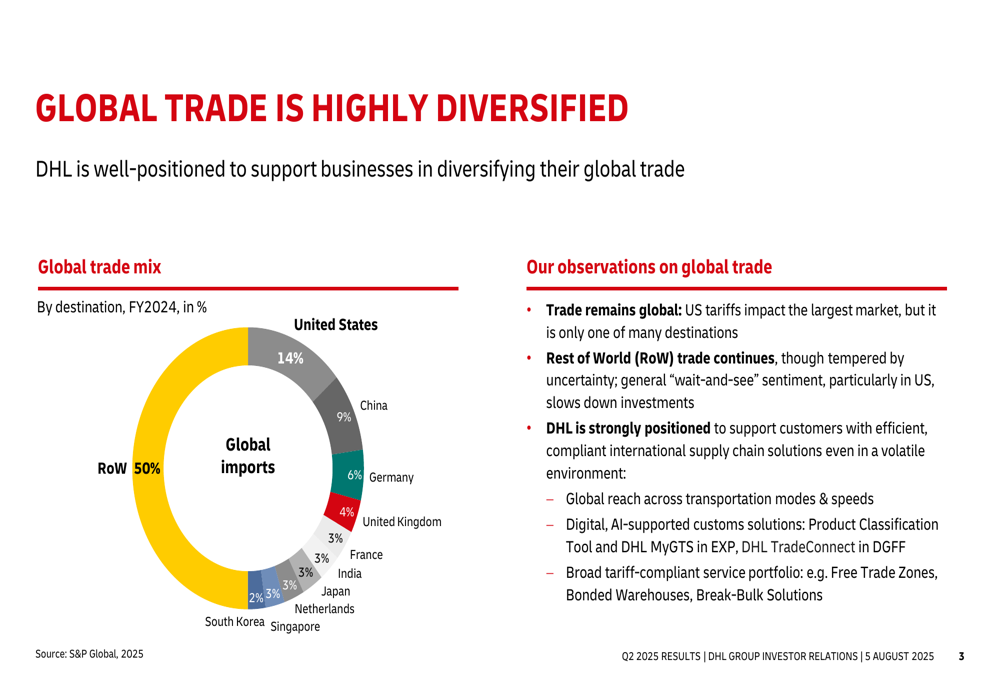
"Trade remains global," noted the company in its presentation, while acknowledging that "US tariffs impact the largest market, but it is only one of many destinations." This perspective aligns with the company’s previous statements from Q1, where it reported limited impact from US trade tensions.
Quarterly Performance Highlights
DHL’s Q2 2025 financial performance showed resilience with net profit increasing 10% year-over-year to €815 million and basic earnings per share rising 13% to €0.72. Operating cash flow grew 6% to €1,710 million, though free cash flow excluding net M&A declined 9% to €329 million.
The company’s first-half 2025 results maintained the positive momentum seen in Q1, with H1 EBIT reaching €2,799 million, a 5% increase year-over-year, consistent with the growth rate reported in the first quarter.
The following slide summarizes the group’s key financial metrics:
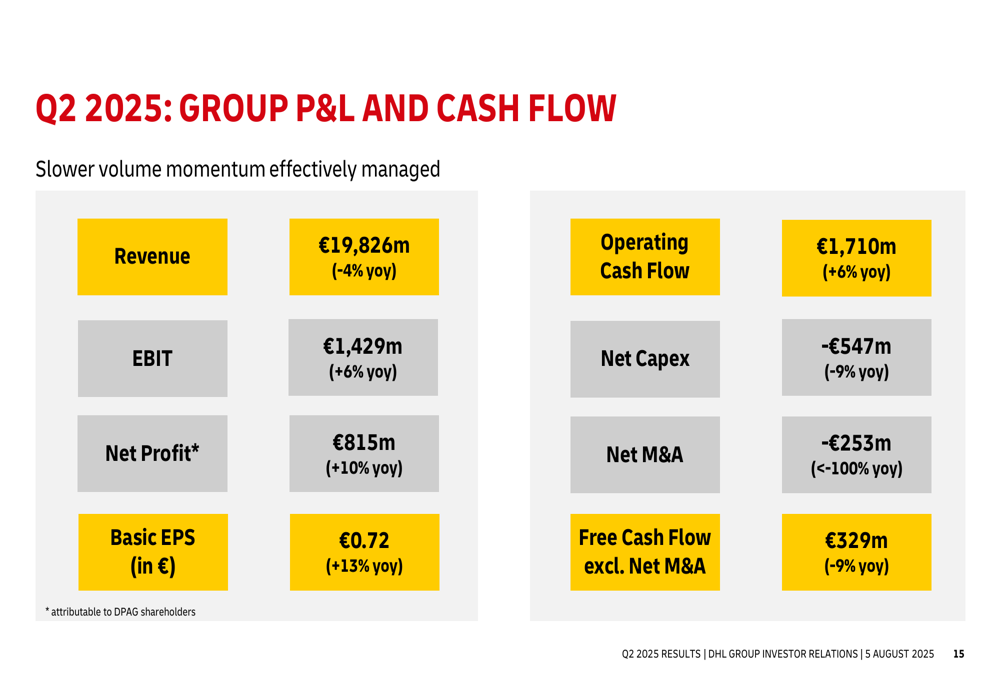
Volume development across divisions showed mixed results, with B2B segments experiencing moderate declines while certain B2C segments demonstrated growth. DHL noted that the "structural e-commerce trend remains fully intact" despite cautious consumer sentiment in some markets.
The company’s volume trends across divisions are illustrated here:
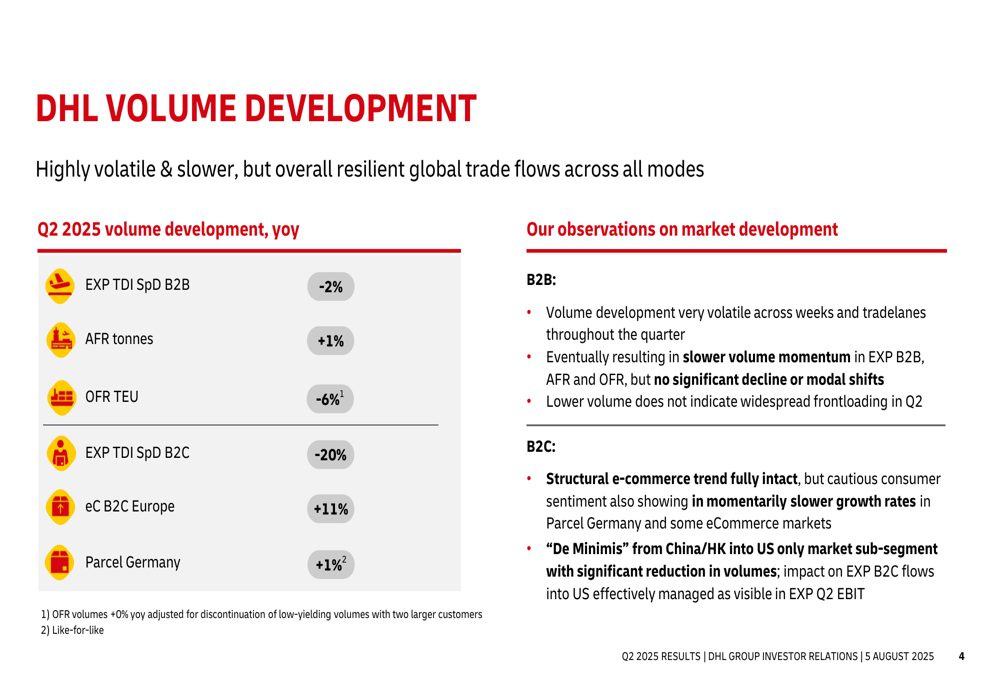
Divisional Performance Analysis
DHL’s performance varied significantly across its five divisions, with three showing strong growth while two faced challenges:
DHL Express delivered a 7% EBIT increase to €730 million despite a 10% decline in time-definite international shipments per day. The division effectively managed costs through a 7% reduction in air capacity and implemented price increases, achieving a 4% improvement in revenue per kilogram.
DHL Global Forwarding, Freight experienced a 30% EBIT decline to €196 million amid slower volume momentum, though gross profit per unit remained stable. Air freight tonnes increased 1% while ocean freight TEUs decreased 6%.
DHL Supply Chain was the standout performer with a 24% EBIT increase to €348 million, maintaining a strong 7% margin. The division benefited from sector focus and advanced automation capabilities, with 7,600 robots now in operation across 90% of global sites.
The divisional performance breakdown is shown in the following slide:
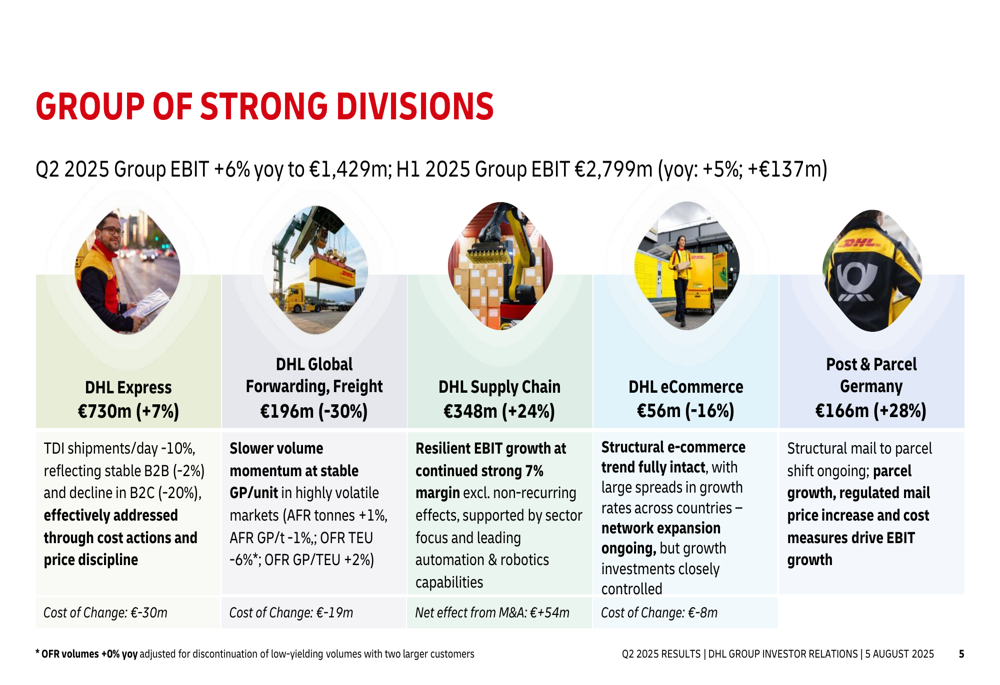
DHL eCommerce reported a 16% EBIT decline to €56 million, though the company emphasized that the "structural e-commerce trend remains fully intact" with significant growth variations across countries. Turkey led with 28% growth, followed by Spain (13%), Poland (6%), Belgium (5%), and Great Britain (2%).
Post & Parcel Germany delivered impressive results with a 28% EBIT increase to €166 million. While mail volumes declined 9%, parcel volumes grew 1%, driving a 4% revenue increase in the parcel segment. The regulated mail price increase and cost measures contributed to the strong performance.
The P&P Germany performance is illustrated in this chart:
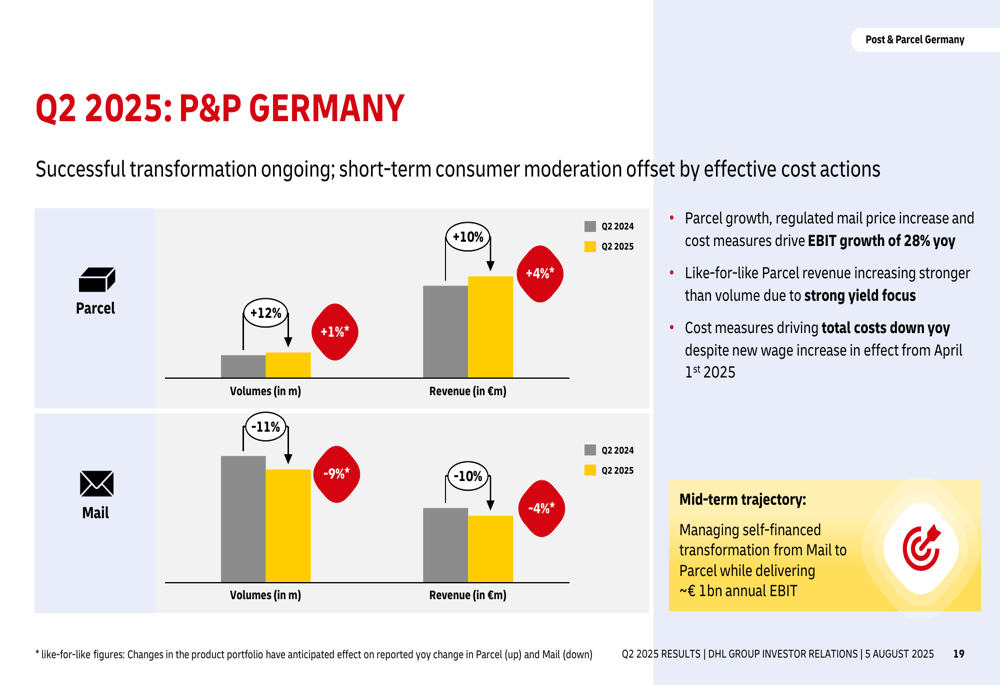
Strategic Initiatives
DHL continues to execute its Strategy 2030 initiatives, focusing on high-growth sectors and geographic expansion. The company is making targeted investments in Life Sciences & Healthcare, New Energy, Geographic Tailwinds, E-commerce, and Digital Sales.
Key strategic investments include:
- Continued investment in next-generation Life Sciences & Healthcare logistics
- Partnership with Fortum (HE:FORTUM) Battery Recycling for circular economy initiatives
- €500 million investment in the Middle East by 2030
- Ongoing investments in e-commerce capacity, lockers, and automation
- Expanded partnership with Boston Dynamics for robotics innovation
The company’s strategic investment priorities are shown here:
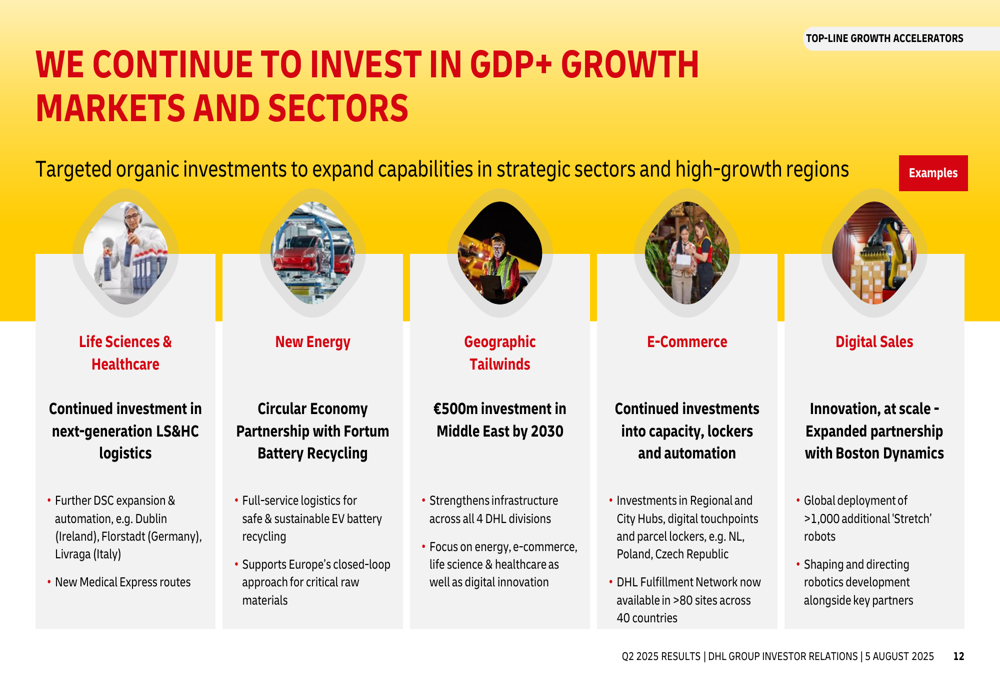
DHL’s "Fit for Growth" program is delivering significant cost improvements, complementing effective capacity management. The company reported a 7.7% reduction in aviation costs, 5.2% decrease in pick-up and delivery costs (17.2% in the US), 1.3% reduction in hub costs, and 3.2% decrease in direct full-time equivalent employees.
These cost management initiatives are detailed in the following slide:
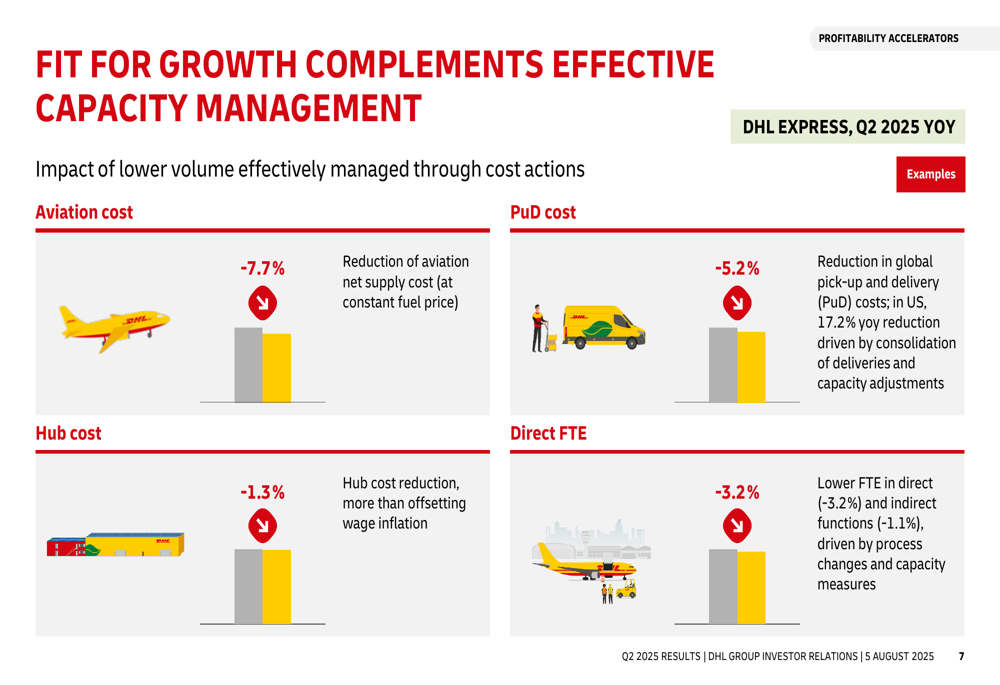
M&A activities in the first half of 2025 focused on strategic value-add capabilities rather than scale. Acquisitions included IDS and INMAR for e-commerce capabilities, CRYOPDP for life sciences and healthcare, and AJEX and EVRI for geographic expansion and market position strengthening.
Outlook & Guidance
DHL maintained its unchanged guidance for fiscal year 2025, expecting Group EBIT of at least €6.0 billion, with DHL divisions contributing at least €5.5 billion and Post & Parcel Germany approximately €1.0 billion. The company forecasts free cash flow excluding net M&A of around €3.0 billion and gross capital expenditure excluding leases of €3.0-3.3 billion.
The guidance is based on a "continued muted macro environment" and does not account for "potential further escalation in tariff or trade policies."
The company’s full guidance is presented in this slide:
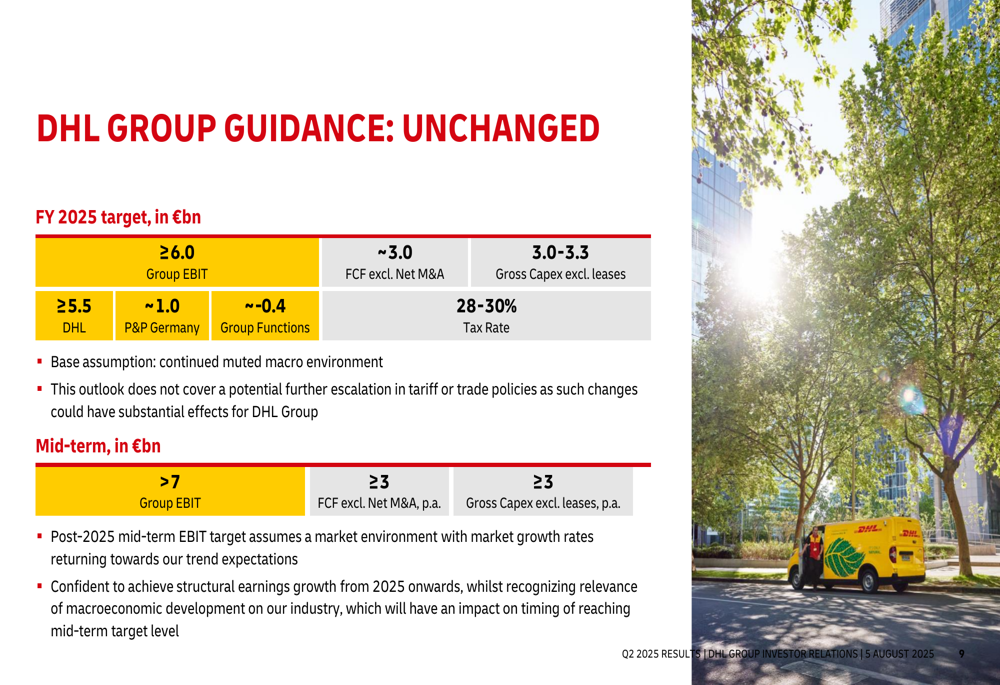
For the mid-term, DHL targets Group EBIT exceeding €7.0 billion, maintaining its commitment to dividend continuity as evidenced by the €2.1 billion dividend payment in 2025. The company also executed €0.9 billion in share buybacks during H1 2025 as part of its accelerated and expanded €6 billion program, with up to €2 billion remaining until the end of 2026.
"We continue to invest in GDP+ growth markets and sectors," the company emphasized, highlighting its focus on sustainable long-term growth despite short-term volume challenges.
Full presentation:
This article was generated with the support of AI and reviewed by an editor. For more information see our T&C.
